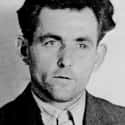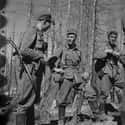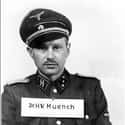-
(#1) Mission Of Mercy
On December 20, 1943, American B-17 bomber pilot Charlie Brown and crew attempted to bomb an aircraft production facility in Germany. The factory was surrounded by 15 anti-aircraft guns, which damaged Brown's B-17. The damaged aircraft was set upon by German fighter planes, which seriously wounded several crew members and knocked out all but one of the plane's engines.
While the fighters turned their attention to other prey, Brown's B-17 was spotted by German fighter pilot Franz Stigler, who was refueling. Stigler caught up with the plane and was about to blast them when he saw the crew was seriously wounded. Stigler was reluctant to attack a defenseless aircraft, so he instead pulled alongside the B-17 cockpit and signaled the crew to land. They refused. He then motioned in the direction of Sweden, but the Allied crew didn't understand. (Who would really? "Oh, right, you mean Sweden, of course.")
Stigler flew side-by-side with the bomber, afraid his own military might identify him (his behavior could have gotten him executed). As the bomber approached the safety of the English Channel, Stigler saluted and peeled off. Miraculously, Brown kept the plane in the air and made it to England. He often wondered why his German counterpart hadn't shot him down so, after the war, he placed an ad in a WWII newsletter for pilot veterans. Stigler, who relocated to Canada, spotted the ad. The two reunited, and Stigler explained that to shoot at them would have been dishonorable. The pair became close friends until they passed 2008.
-
(#2) The Art Forger And The Reichsmarschall
In May 1945, in the Netherlands, an art dealer named Han Van Meegeren was arrested and charged with selling a Vermeer painting to Hermann Goering, a leading member of the Nazi party. This form of collaboration carried a capital sentence, and Van Meegeren was wise to confess to a lesser but no less remarkable crime: He claimed the work in question was a forgery, and that he had forged it and other Vermeers that art appraisers had deemed genuine.
Before WWII, Van Meegeren, an aspiring artist who disliked modern art and was frustrated by being ignored, began forging paintings to mock the art establishment. After his first forgery was declared a genuine Vermeer and sold for millions, Van Meegeren created more. By 1943, he earned the equivalent of $60 million. One of his paintings was sold to Hermann Goering via a dealer, who implicated Van Meegeren after the work was recovered with other Nazi art.
The court dismissed the collaboration charge, convicted him of forgery, and sentenced him to a year in jail. While Van Meegeren's attorneys appealed, the forger perished of a heart attack in December 1947.
-
(#3) 'The Man Called Richard Sorge Is Unknown To Us'
Richard Sorge was born in Russia in 1895 to a Russian mother and German father. He moved with his family to Germany, where he enlisted in the German Army in 1914, was seriously wounded in WWI, earned a PhD, and became a Marxist. He fled to the USSR, became a spy, was assigned to China, and was directed to begin covert operations in Japan. To do so, he traveled to Germany, established cover as a journalist, and was successfully introduced to Eugen Ott, the German military attaché in Tokyo.
Sorge's journalism built his reputation as an expert on Japan, and his frank opinions on Nazi policy and leadership and his drunken philandering added to his cover - what spy would act like this? Ott had Sorge accompany him on an official mission to Manchuria, and Sorge's report was forwarded to Berlin, where it was deemed strategically valuable. Sorge even seduced Ott's wife, but the attaché shrugged it off; he needed Sorge's input that much. He dubbed Sorge "the Irresistible."
By 1938, Ott was promoted to ambassador of Japan and had Sorge read his cables and reports before they were transmitted to Berlin. As Germany began its buildup for a full-scale invasion of the USSR, Sorge sent warnings, giving Moscow the specific date of the invasion. Stalin ignored this as a Western "provocation" and the Nazi invasion was initially a Soviet disaster. Stalin believed his spy when Sorge relayed information that Japan would not invade the USSR unless the Russians surrendered, allowing Stalin to shift Asian resources to the defense of Moscow. Sorge also predicted Japan would attack Indochina and American possessions in the Pacific, his last major accomplishment.
Sorge was arrested and condemned. But both Japan and Sorge figured he would never hang. When the Japanese tried, on three separate occasions, to exchange Sorge, the Soviets replied, "The man called Richard Sorge is unknown to us." Stalin systematically eliminated anyone with knowledge of his failure to respond to the imminent German attack, including Sorge's ex-wife, who was sent to a Siberian labor camp. The Japanese finally gave up on exchanging Sorge and hanged him in 1944. In 1961, a French film about Sorge became popular in the USSR and, after personally investigating the case, Nikita Khruschev named him Hero of the Soviet Union, the USSR's highest honor.
-
(#4) Mildred Harnack, the Only American Female Executed for Espionage by the Nazis
Mildred Fish was a grad student at the University of Wisconsin-Madison when she met Arvid Harnack, a Rockefeller Fellow from Germany. They married in 1926 and moved to Germany, where Mildred worked in academia and Arvid secured a position close to Soviet intelligence contacts. Throughout the '30s, Mildred and Arvid, alarmed by Hitler's rise to power, communicated with a close circle of associates who believed communism and the Soviet Union might be the only possible stumbling block to complete Nazi tyranny in Europe.
When war was declared in 1941, she did not leave with other American expatriates. By then, Mildred and Arvid were involved with a communist espionage network known by the Gestapo as "The Red Orchestra." The ring, which provided important intelligence to the USSR, was compromised and the members were arrested.
Arvid was sentenced to death and executed on 1942. Mildred was given a six-year sentence, but Hitler refused to endorse her punishment and she was retried and condemned on February 16, 1943. She was beheaded by guillotine. Because of her connection to possible communist sympathies and post-war McCarthyism, her story is virtually unknown in the US. However, Fish is beginning to get well-deserved recognition.
-
(#5) The D-Day Medic Heroes Of Angoville-au-Plain
In the early hours of June 6, 1944, thousands of allied paratroopers were dropped behind enemy lines in anticipation of the invasion of Normandy. One of the main objectives of the 101st Airborne was to capture the small village of Angoville-au-Plain. When intense fighting broke out over the village, two American medics, Robert Wright and Kenneth Moore, set up a medical station in the tiny town church.
US paratroopers established control of Angoville-au-Plain, but German units quickly counterattacked and forced American troops back. Wright and Moore stayed behind, and when German soldiers entered the church, they were hostile to the Americans until they realized the medics were treating their wounded, as well. They left, posting a Red Cross flag at the entrance. For three days, the fighting raged on and the village changed hands several times, but the two medics toiled away, saving 80 lives, including a local teenager.
Today, all of the stained glass windows in the church (the originals were destroyed in the battle) are tributes to Wright, Moore, and the 101st Airborne. Wright visited the church in 2004, and some of his ashes were spread in Angoville-au-Plain's cemetery.
-
(#6) Oradour-sur-Glane, The Town That Died Forever
The Allied invasion of Normandy instigated widespread activity by the French Resistance, including the kidnapping and killing of Helmut Kampfe, a major in the Waffen-SS Das Reich. In the wake of Kampfe's demise, a battalion of the regiment known as Der Fuhrer Regiment made its way to the small village of Oradour-sur-Glane.
Commander Adolf Diekmann ordered the town sealed off, the men locked in barns, and the women and children confined to the church. It's unknown why the town was selected - possibly due to its proximity to the regiment, or because Germans knew it was defenseless.
Diekmann ordered his unit to begin shooting. Residents were incapacitated by shots to the legs, then the barns and church were doused with gasoline and ignited. Hundreds of villagers perished, which was nearly all the residents of the area. Many of the SS present were Alsatian French nationals forced into the German military, and almost all participants escaped punishment. After WWII, French president Charles De Gaulle declared that the village would never be restored, and left as a reminder of the brutal Nazi occupation.
-
(#7) The Amazing And Mostly Forgotten Georg Elser
In November 1939, German carpenter Georg Elser set out for Munich. He was alarmed by what was happening in Germany and wanted to assassinate Hitler before the dictator dragged the country into another costly war. Elser knew Hitler frequently changed his itinerary at the last minute as a security measure, but the one event he never failed to attend was the anniversary celebration of the 1923 Beer Hall Putsch, the first attempt by the Nazis to seize power. Hitler spoke annually at the site where the putsch began, the Burgerbraukeller beer hall.
When Elser checked out the hall, he noticed a pillar supporting a balcony over the speaker's dais, the perfect spot to plant a bomb. After 30 straight nights of chiseling the pillar, Elser hollowed out a place for his intricately designed, timed explosive device, which was set to detonate right in the middle of Hitler's traditional 90-minute speech. Elser was so methodical, he lined the hole with cork to muffle the ticking clock of the bomb and put tin around it so any attempt to nail decorations through his device would be repelled.
Everything was in place three days before Hitler's November 8 speech. Unfortunately, Hitler was planning to attack France on November 12, 1939. Although he eventually postponed the invasion until spring 1940, Hitler wanted to quickly return to Berlin to oversee the operation. He cut his speech to an hour so he could catch a train back to Berlin. Just 12 minutes after Hitler left, Elser's bomb went off, killing seven people and injuring 63. The carpenter was on his way to the Swiss border, having scouted a route through the frontier months ago.
But Elser hadn't counted on wartime security and was detained as he approached the border. He was arrested and tortured before being placed in the Dachau concentration camp. Hitler was convinced the Allies were behind Elser's conspiracy, and the carpenter was kept alive in the hopes of eventually staging a show trial. However, the imminent end of the war forced Hitler's hand. Elser was secretly executed at Dachau in April 1945. The exact date is debated.
-
(#8) The Execution Of Eddie Slovik
Edward D. Slovik was drafted into the Army in early 1944. His numerous criminal convictions initially disqualified him from service, but after getting married and avoiding trouble, Slovik was sent to France in August 1944. Slovik and a buddy essentially deserted and didn't arrive with their replacement unit until October, but such confusion was common in the chaos of the war, and their absence was overlooked. Slovik informed his company commander he was frightened and didn't want to serve on the front lines.
Slovik's request for reassignment was refused. He subsequently deserted, walking until he reached a rear headquarters unit. There, he presented his commanding officer with a note repeating his refusal to serve in the front lines and his promise to desert if so assigned. He was placed in the stockade and, despite numerous offers to drop charges if he would return to his unit, Slovik refused, figuring that, at worst, he would get a prison sentence. He was court-martialed, refused to testify, was convicted, and sentenced to death. Because desertion was a serious issue, it was believed the military, including General Eisenhower, who signed off on the execution, wished to make an example of Slovik.
On January 31, 1945, he was shot by a firing squad, the only US soldier to be executed for desertion in the 20th century. He was buried in France, in a secluded part of a US military cemetery, until 1987, when President Reagan allowed his reburial in Michigan, next to his wife. In 1974, a film starring Martin Sheen entitled The Execution of Private Slovik was released.
-
(#9) The Anti-Communist Finn Who Served Everywhere
Lauri Torni, AKA Larry Thorne, was born in Finland and, somewhat improbably, perished as an American Green Beret in Vietnam. Torni entered the Finnish military service in 1938. He participated in the war between Finland and the USSR, distinguishing himself in battle, earning the rank of captain. When Finland allied itself with Nazi Germany in 1941, Torni fought for three years as commander of the fearsome Detachment Torni, until the Finnish armistice of 1944.
After his unit demobilized, Torni joined a German SS unit and continued to fight the Russians. He was captured by the British, escaped a POW camp, and returned to Finland, where he was arrested for his German army service. Pardoned in 1948, Torni secretly traveled to Sweden, masqueraded as a Swedish seaman, and sailed to the vicinity of Mobile, Alabama, where he jumped overboard and made it to land. He was granted residency in 1953 and joined the Army as Larry Thorne. Eventually, he became a Green Beret assigned to Special Forces, and served in various high-profile capacities around the world.
In 1963, he deployed to Vietnam as an advisor, but two years later, Torni's remarkable career came to an end when his helicopter crashed during a secret mission. His remains were not located until 1999 and were subsequently buried at Arlington National Cemetery in 2003.
-
(#10) Hans Munch, 'The Good Man Of Auschwitz'
The conduct of Nazi staff at Auschwitz is an appalling chapter in human history. The cruelty routinely perpetrated was so egregious that, in 1947, a Polish court convened a special tribunal to mete out justice to 40 former Auschwitz personnel. Of the defendants, only Dr. Hans Munch was acquitted.
Former prisoners testified that Munch had been kind and humane; he gave them food and extended bogus experiments on female prisoners because he knew they would be gassed once the experiments were concluded. Most impressive, Munch refused to participate in the selection process dictating who lived or perished at Auschwitz. In the final days of WWII, his last official act at a concentration camp was to advise an inmate on how to escape, wish him good luck, and hand him his service revolver.
-
(#11) Liquor Bottles Almost Killed Hitler
Adolf Hitler survived several serious assassination attempts, none more dangerous than the March 14, 1943, bombing attempt masterminded by General Henning Von Tresckow. Hitler had flown to the general's headquarters in Smolensk, USSR, for a visit to the front lines. Von Tresckow asked an aide on Hitler's staff to take some liquor bottles wrapped in brown paper to Hitler's HQ and, eventually, deliver them to another officer in Berlin. Actually, the package was a bomb, primed to detonate while the plane was aloft. When Hitler's demise occurred, conspirators would launch a coup in Berlin.
But Hitler's plane landed without incident, and a stunned Von Tresckow quickly sent a subordinate by plane to retrieve the device, lest they all be compromised. Von Tresckow was also involved in the July 20 plot in 1944. When he heard of the plot's failure, he took his own life.
-
(#12) Agent Garbo Got Medals From Both Sides
Juan Pujol, AKA Garbo, is one of the most improbably successful intelligence agents in the annals of warfare. A Spanish hotel manager who developed a rabid hatred of fascists and Germany, Garcia offered his services at the British embassy. They laughed him out of the building, convincing the Spaniard that the only way to impress the British was to infiltrate the German intelligence service, Abwehr.
Garcia headed to Lisbon, involved himself in the intrigue of the Portuguese capital, and was soon sending Abwehr a stream of bogus intelligence supposedly gleaned while traveling through Britain. In truth, he never left Lisbon, and was concocting information from films, newspapers, and even phone books. The stream of information earned him the trust of the Germans, and Garcia was given missions. With this success to his credit, he talked his way into an interview in Britain with MI5. He was given the code name Garbo, after actress Greta Garbo, for his ability to spin convincing narratives out of thin air, and was put to work sending credible disinformation to the Germans.
Garbo's crowning achievement was his involvement in the operation to deceive the Nazis about the location of the Normandy invasion. He not only mislead the German high command about the location, but convinced them the D-Day landing was a diversion for an attack elsewhere. He was such an important asset to the Nazis (or so they thought), he was awarded the Iron Cross. He also received the MBE from the British in December 1944. After WWII, Garbo deliberately faded into obscurity, fearing Nazi reprisals, and relocated to Venezuela, where he passed in 1988.
-
(#13) The Sinking of the Cap Arcona, Worse Than the Titanic
In 1927, the German Hamburg South-America Line launched Cap Arcona, a passenger ship meant to to rival the size and luxury of the Titanic. It was the largest, fastest ocean liner between Europe and South America. With the onset of WWII, Cap Arcona was conscripted into a naval HQ. Briefly involved in a dramatic film orchestrated by Josef Goebbels, the ship sat rusting in the Baltic until the final days of WWII.
Negotiations took place between Heinrich Himmler and Count Bernadotte of Sweden to use Cap Arcona and other, smaller craft to transport Scandinavian concentration camp prisoners to safety in Sweden in 1945. The British, believing Cap Arcona would be used by escaping military SS, attacked the ship, as well as other craft in its vicinity, not knowing German prisoners were still onboard. The bombing killed all but 50 of the 2,800 people aboard. This friendly fire incident remains one of the worst disasters in maritime history.
-
(#14) The Not-So-Great Escape
Allied POW escapes in Europe have been the stuff of legend since WWII ended. But 400,000 Germans prisoners were housed across the US during WWII. On December 23, 1944, 25 of these men attempted to escape from a Papago Park, Arizona, prison camp. The POWs were all U-boat officers or crew and were determined to get to Mexico, then home to Germany. In preparation, they sold fake German medals to guards to obtain cash, created phony IDs, and three men even created a raft they hoped to sail down the nearby Gila River.
By December, a tunnel was successfully built to get the Germans out of the compound. Late on Friday the 23rd, while many of the other 3,000 prisoners acted as though nothing was going in, the 25 men, in small groups, made their way out through the tunnel.
The FBI and Native-American scouts were mobilized. By then, some of the Germans, stranded in cold, rainy weather, turned themselves in. The rafters got to the Gila, but it was essentially an elongated mud puddle, rendering the raft useless. They were captured near the riverbank. Within a month, the last prisoner was arrested by police in downtown Phoenix at a railway station.
New Random Displays Display All By Ranking
About This Tool
World War II is a disaster that mankind cannot forget. Almost everyone who has learned human history will more or less know some important historical events during World War II. World War II was one of the cruelest wars in human history, thousands of people died in this war. There are many amazing stories that happened in this special period, some of which are familiar and others are little known.
Over the decades, as mankind’s self-reflection on wars and exploration of history, some new stories during World War II have begun to emerge. The random tool shares 14 little-known stories from World War II that you can not know from history books.
Our data comes from Ranker, If you want to participate in the ranking of items displayed on this page, please click here.
























